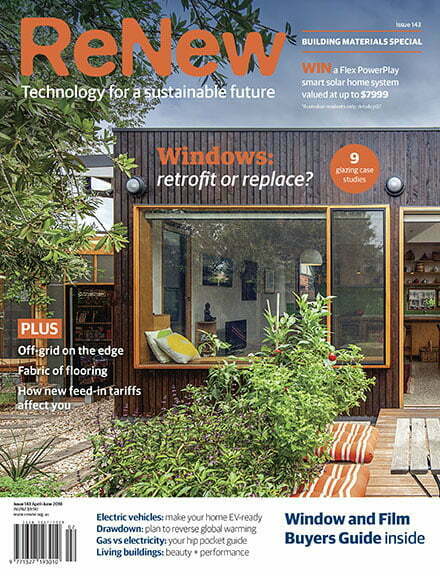Drawdown: A plan to reverse global warming
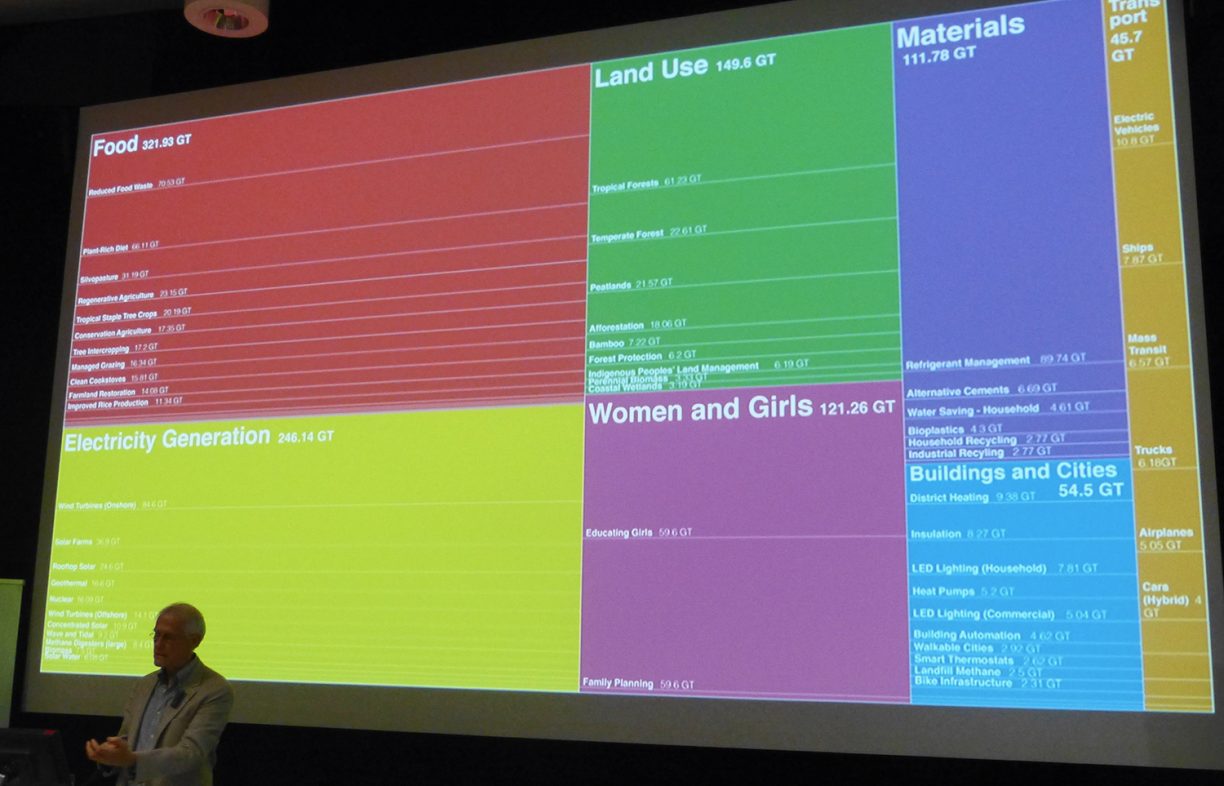
Paul Hawken’s Drawdown project brings together peer-reviewed science on the “top 100 solutions to climate change”, highlighting the benefits and costs of each. Renew member Tom Hunt met with him recently in Melbourne.
This article was first published in Issue 143 (Apr-June 2018) of Renew magazine.
In mid February, I was privileged to meet Paul Hawken in Melbourne while we were both touring Australia. I was merely on holidays while the US environmentalist, entrepreneur, journalist and author was presenting the Drawdown project to a large and enthusiastic audience at an event organised by Sustainability Victoria at RMIT. Having presented on the Drawdown project myself at our local Renew (formerly ATA) branch meeting in Wollongong, I was keen to meet the man behind it all. I learned more than I expected during a spare 15 minutes he had before his presentation—including some good advice about yoga for my ailing back!
Drawdown, the book, is Paul Hawken’s latest bestseller, but it is far more than a well-illustrated and readable tome. It represents the combined work of 70 scientists and researchers, and tells an inspiring story of the most important things we can do to combat climate change. It calculates just what we can achieve in terms of greenhouse gas emission reduction by applying the technologies and knowledge already at our disposal. The book is supported by the drawdown.org website, which also presents the data in a very accessible way, gives more information on the methodologies and updates the results as research continues.
What is drawdown?
The solutions in this book reduce the amount of carbon emitted, and in some cases take carbon out of the atmosphere (e.g. afforestation), but the ultimate goal, referred to in the book as ‘drawdown’, is to reduce the total amount remaining in the atmosphere. The book notes that when that can be achieved depends not just on emission reduction and taking carbon out of the atmosphere, but also on the complex interaction of global warming with the ocean and other carbon sinks; because of increased warming, the oceans may not be able to absorb and store as much carbon; similarly, as temperatures rise, soil, grasslands and forests can dry out and emit more carbon than they sequester. The book contends this means we need to address global warming as aggressively as possible now.
Deciding what’s important
So what is the most important thing to focus on in the battle to combat climate change? Is it more important to replace coal with wind turbines, to put solar on every rooftop, to switch to electric vehicles or just to stop eating meat?
This is the type of question many people have posed, but few have properly explored. Back in 2001 Paul Hawken started asking the experts: “Do we know what we need to do in order to arrest and reverse global warming?” But the experts had no overall picture, only the knowledge within their own spheres of expertise.
Greenhouse gases are at an all-time high. In 2013 Paul was so concerned by talk of the unthinkable ‘game over’, he decided to pull together all the experts he could and work out, for us all, just where we stand on global warming with the options we have.
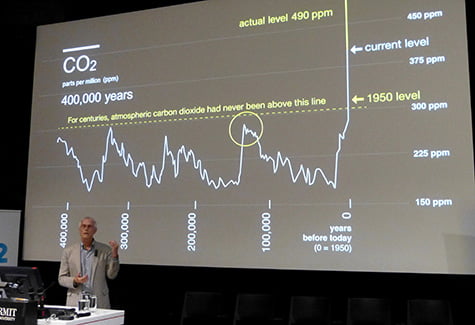
Drawdown, touted on the cover as “the most comprehensive plan ever proposed to reverse global warming”, was on the New York Times bestseller list within a few weeks of its release mid last year. The very readable book gives a brief chapter to each of 80 well-researched currently available solutions and to a further 22 upcoming technologies that hold great promise.
Each of the 80 proven solutions comes with a solid calculation of what effect it can have on slowing global warming, measured in gigatonnes of CO2-e (CO2 and equivalent gases) reduction. For each solution, the research considers the resources and infrastructure required, and the costs, and estimates what can be achieved within the next 30 years, as a plausible target for implementation.
Also contained are chapters on 22 very promising but as yet not-fully-explored solutions that can take us further, to draw down the atmospheric CO2 to a level we can live with.
History of each tech
The text includes short histories and examples of each technology, along with other related stories such as ‘The man who stopped the desert’, ‘The secret life of trees’ and even Pope Francis’s encyclical letter ‘On care for our common home’.
The short histories alone are worth a read, with many golden snippets to be found. I was impressed to learn that Henry Ford originally worked for Thomas Edison who encouraged Ford’s venture into car manufacture, preferring an electric motor; however, Edison was unable at the time to create a dense-enough battery to fulfil his dream of “no water-circulating system to get out of order, no dangerous and evil-smelling gasoline, and no noise.”
What are the solutions?
The solutions fall into several sectors: energy, food, land use, transport, buildings and cities, materials and, intriguingly, women and girls.
As well as all the expected technologies, the solutions include such diverse things as indigenous people’s land management and building automation, and range from food composting to high-speed rail, from ‘silvopasture’ (forest grazing) to smart glass. Indeed, they present a range of technologies that are as interesting to read about as they are practical.
The ‘Coming attractions’ section presents some intriguing possibilities. Projects around the world are busily working to develop effective solutions from all kinds of ideas—marine permaculture, living buildings (see our article on the Living Building Challenge in Australia, in Renew 143), enhanced weathering of minerals to absorb carbon from the atmosphere and more.
One inspiring chapter titled ‘A cow walks onto a beach’ explores a promising new avenue. It seems adding seaweed to the diet of ruminants such as cattle and sheep can significantly reduce the methane they produce. In one experiment, a flock of sheep with seaweed as 2% of their feed reduced the methane they produced by 70% to 80%.
The top solutions, ranked by the amount they reduce CO2-e going into the atmosphere, are an interesting bunch (see Table 1).
Refrigerant management was an unexpected leader. The gases used in air conditioners and refrigerators are changing from the ozone-depleting ones, but are still thousands of times more powerful greenhouse gases than they need to be. The potential reduction is in correctly managing the decommissioning in existing installations and switching the world to using better refrigerant gases; the latter is already agreed to internationally, but it will take time.
Population growth (often seen as the elephant in the room) is addressed through educating girls and family planning, primarily in developing countries.
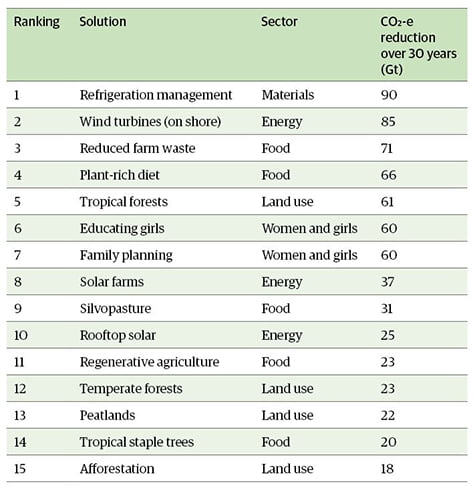
Can it work?
Using peer-reviewed science, economic analysis by the ‘big four’ accounting firms and, as Paul Hawken says, “just doing the sums”, it looks like if we work on all of these solutions, we have a chance of containing the climate change issue. But no single approach or technology can solve the problem; it seems we need to use them all. As Paul Hawken said to me, “There is no such thing as an unimportant organ in our bodies.”
Drawdown takes into account the difficulty of transitioning our society and makes what I feel are very conservative estimates of the potential uptake of technologies over the next 30 years. I asked Paul about some of these estimates; for instance, his numbers assume that electric vehicle usage rises to 16% of total passenger miles by 2050—I’m confident it could be much more than that. He replied, “Yes, I’ve received several criticisms about being overly conservative, but that’s far preferable to concerns of being too optimistic, and it gives more credibility to the data.”
Reading the book has made me feel more optimistic that we can kick climate change, if only we can implement all these solutions at the levels and in the timeframe suggested.
Given Paul’s knowledge of economics (he’s author of several bestsellers such as Ecology of Commerce, Blessed Unrest and Natural Capitalism), I asked him what he thought was the best way to accelerate these solutions since … well … it’s more than a quarter of a century since the UN called for action and yet the world is still adding more carbon than ever to our skies.
“Carbon pricing would do more to accelerate all these climate change solutions than any other single policy that I know of or can even imagine,” he replied. “It couldn’t happen soon enough or fast enough in my opinion.”
Arron Wood, acting Lord Mayor of Melbourne followed this response with: “I wish Australia had a working carbon price— imagine if we had one.”
This article was first published in Issue 143 (Apr-June 2018) of Renew magazine. Issue 143 is our building materials special and includes a window buyers guide and an in-depth look at sustainable flooring options.
Recent articles
 Pears Report
Pears Report
Fossil fuels, efficiency and TVs
Alan Pears brings us the latest news and analysis from the energy sector.
Read more Climate change
Climate change
What we can learn from Spain’s response to heatwaves
As Australia heads into a summer set to be marked by climate change and El Niño, resilience to extreme heat is front of mind. Renew’s Policy and Advocacy Manager Rob McLeod reports on Spanish responses to heatwaves and the lessons for Australia.
Read more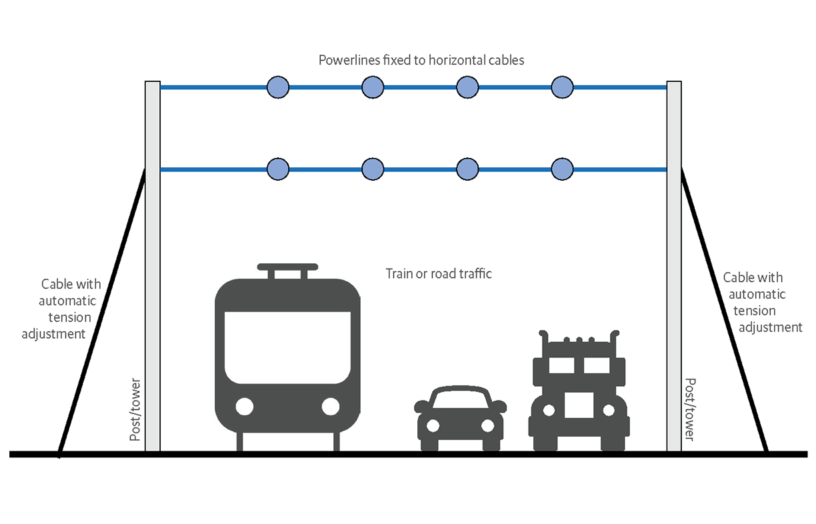 Pears Report
Pears Report
Transmission and emissions
Alan Pears brings us the latest news and analysis from the energy sector.
Read more

